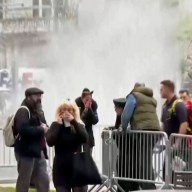
Credit: International Film Circuit
‘Ai Weiwei: The Fake Case’
Director: Andreas Johnsen
Genre: Documentary
Rating: NR
3 (out of 5) Globes
“Ai Weiwei: The Fake Case” is not just the sequel to 2012’s “Never Sorry”; it’s the flipside. Where the first one — a profile that found the Chinese artist moving from political-themed to an outright enemy of the state — was a giddy romp in which he was always surrounded by his legions of fans, “The Fake Case” finds him alone, quiet and seemingly frightened of what the Chinese government could do to him. He’s exhausted, flustered and, to the world, silent, uncharacteristically shunning the press and no longer updating his Twitter feed. Or is this itself a stunt? Weiwei’s silence is deafening, itself a form of protest. It makes the government look even scarier than it was before; if they can get shut Ai Weiwei up they can do it to anyone.
“Never Sorry” ended chillingly, with Weiwei spirited away to an unknown place for detainment and his studio razed. “The Fake Case” picks up where it left off, with Weiwei returning to his compound, visibly spooked. He’s not talking to anyone — except the documentary crew filming him, of course. And as the cameras roll, he’s making his own documentary about his life. It’s not clear whether what happened to him spooked him or if this is a long con.
The narrative this time is less freewheeling, if no less vital. Swapping the first film’s montage-heavy style for a verité hangout vibe, it finds him under house arrest, but still semi-quietly continuing to rebel. Chief among his moves is the art piece “S.A.C.R.E.D.,” a recreation of his detainment that is packed up in boxes and sent to museums in the outside world.
But he’s mostly pessimistic, if still irascible. A car chase, with Weiwei giddily filming a car tasked with following him, or a stretch where he sets up webcams in his house, allowing everyone to do what the Chinese government is doing to him already, briefly bring back the “fun” of the first film. But he’s more introspective. He talks with his mom about the government’s tactics in the past, which were once even more severe. He tries to rationalize to a friend about a past quote he made that no artist should be political. And he worries about his reputation.
He’s become a brand, but the film finds him all too human — sometimes fighting back, sometimes throwing up his hands. He’s not in a good mood this time, and not even a scene where he accepts an award over Skype can cheer him up. But as with any good franchise, the inevitable threequel will no doubt find him raging back to life after a lumpy, engagingly dispiriting middle chapter.
Follow Matt Prigge on Twitter @mattprigge
















